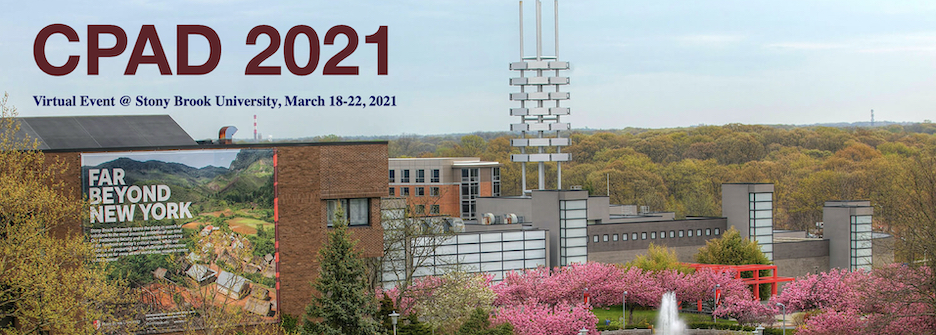Conveners
TDAQ
- Isobel Ojalvo (Princeton University (US))
- Georgia Karagiorgi (Columbia University)
TDAQ
- Isobel Ojalvo (Princeton University (US))
- Georgia Karagiorgi (Columbia University)
TDAQ
- Isobel Ojalvo (Princeton University (US))
- Georgia Karagiorgi (Columbia University)
TDAQ
- Isobel Ojalvo (Princeton University (US))
- Georgia Karagiorgi (Columbia University)
The muon campus program at Fermilab includes the Mu2e experiment that will search for a charged-lepton flavor violating processes where a negative muon converts into an electron in the field of an aluminum nucleus, improving by four orders of magnitude the search sensitivity reached so far.
Mu2e’s Trigger and Data Acquisition System (TDAQ) uses {\it otsdaq} as its solution. Developed at...
The “muon-to-electron conversion” (Mu2e) experiment at Fermilab will search for the Charged Lepton Flavour Violating neutrino-less coherent conversion -N(A,Z) e-N(A,Z) of a negative muon into an electron in the field of an aluminum nucleus. The observation of this process would be the unambiguous evidence of physics beyond the Standard Model. Mu2e detectors comprise a straw-tracker, an...
Every timing detector needs to know the time, and every timing detector needs to refer to the same reference clock. As we push the limits of the timing precision of new detectors, we need to distribute to these detectors a reference clock that has a precision that is much better than the detector's. In this presentation we will describe how we have demonstrated the feasibility of delivering...
The Front-End Link eXchange (FELIX) system is an interface between the trigger and detector electronics and commodity switched networks for the ATLAS experiment at CERN and other experiments. The detector and trigger electronic systems of the ATLAS experiment are largely custom and fully synchronous with respect to the 40.08 MHz clock of the Large Hadron Collider (LHC). The FELIX system uses...
The CMS experiment has adopted ATCA standard for the upcoming Phase-II upgrade. We have developed a novel approach to the design of ATCA boards for this upgrade. Instead of relying on a regular single-PCB framework, with possibly some additional mezzanine cards, the X2O design is using a large heat sink as a main mechanical carrier, with various modules attached to it as needed. The modules...
The Mu2e experiment at Fermilab will search for the charged-lepton flavor violating (CLFV) neutrino-less conversion of a negative muon into an electron in the field of a nucleus. Mu2e-II, a proposed upgrade of Mu2e, aims to improve the expected sensitivity by at least an order of magnitude. This upgrade will require a similar increase in the data rate and the radiation tolerance of the front...
CLAS12 detector is installed at Jefferson Lab’s experimental Hall-B and the purpose of its huge science program is to provide substantial progress in understanding the Quantum Chromo Dynamics (QCD). Such a detector requires a sophisticated trigger and current experiments use an on-line FPGA-based system that relies upon custom firmware and electronics both of which are difficult reconfigure...
The US particle physics community engaged in the Snowmass process is studying collider projects for the post-LHC era. Among those, muon colliders are particularly interesting due to their ability to reach multi-TeV energies in the environment typical for lepton colliders where backgrounds due to other physics processes are significantly lower than at a hadron collider experiment. However, as...
LHCb's second level trigger, deployed on a CPU server farm, not only selects events but performs an offline-quality alignment and calibration of the detector and uses this information to allow physics analysts to deploy essentially their full offline analysis level selections (including computing isolation, flavour tagging, etc) at the trigger level. This “real time analysis” concept has also...
Data-intensive science is increasingly reliant on real-time processing capabilities and machine learning workflows, in order to filter and analyze the extreme volumes of data being collected. This is especially true at the intensity frontier of particle physics. Data filtering algorithms, or trigger algorithms, at the LHC drive the data curation process, funneling event records with certain...
The ATLAS detector at CERN’s LHC will undergo a major upgrade prior to the startup of High-Luminosity LHC which affects all major subsystems including trigger and data acquisition. The new Level-0 hardware trigger will be comprised of legacy as well as new systems, among them the Global Trigger which processes full-granularity calorimeter information at 40 MHz and allows for the execution of...
As detector technologies improve, the increase in resolution, number of channels and overall size create immense bandwidth challenges for the data acquisition system, long post acquisition processing times and growing data storage costs. Much of the raw data does not contain useful information and can be significantly reduced with veto and compression systems. The improvements in artificial...
We describe a method for precisely regulating the gradient magnet power supply (GMPS) at the Fermilab Booster accelerator complex using a neural network (NN). We demonstrate preliminary results by training a surrogate machine-learning model on real accelerator data, and using the surrogate model in turn to train the NN for its regulation task. We additionally show how the neural networks that...
Hls4ml is a user-friendly software, based on High-Level Synthesis (HLS), designed to deploy deep neural networks on FPGAs within applications characterized by tight constraints in terms of latency and resources. In this talk we present the core features of the library and recent progresses in supporting quantization-aware training with arbitrary precision, DNN architectures with large...
